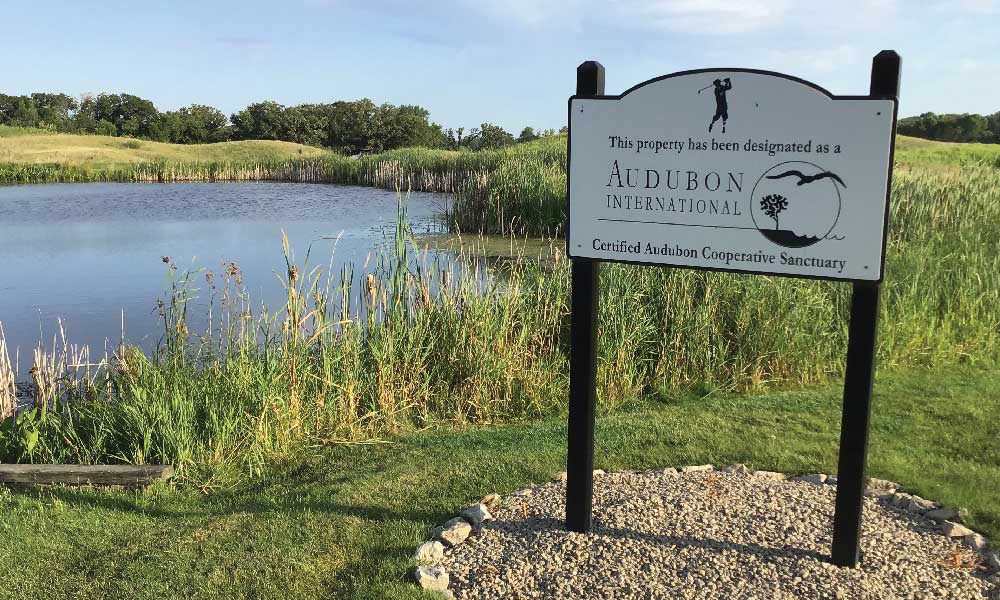The Audubon Cooperative Sanctuary Program for Golf:


Certified Audubon International Sanctuary
The environmental groups, Audubon International and the National Audubon Society, may sound like birds of a feather, but don’t let their names confuse you. Although both organizations pay homage to ornithologist, naturalist and artist, John James Audubon (1785-1851), the two groups are separate and distinct entities.
Both groups are structured as non-profit organizations, and both play important roles in protecting the environment. They have, however, numerous fundamental differences, including their positions on preservation vs. conservation.
By its own description, the National Audubon Society is an environmental organization dedicated to conserving and restoring “natural ecosystems, focusing on birds, other wildlife and their habitats for the benefit of humanity and the earth’s biological diversity .” The National Audubon Society and the approximately 500 state and local Audubon Societies affiliated with it, however, are not involved in the certification of golf courses.
In contrast, Audubon International works in a cooperative effort with the United States Golf Association (USGA) to promote ecologically sound land use practices, natural resource conservation and preservation of the natural heritage of the game of golf. Recognized by the U.S. Environmental Protection Agency for its work, Audubon International advises and certifies many types of properties in addition to golf courses, including ski areas, residential housing developments, hotels, timeshare resorts and even cemeteries.
Related: Chris Young, Superintendent Gaylord Springs Golf Links
Through the certification processes of the Audubon International Cooperative Sanctuary Programs, participants are assisted in developing plans to enhance efficiency, conserve resources and promote conservation. Audubon International’s awards certification is a way to draw attention to and reward environmental achievements and leadership by those who use the group’s services. Audubon International defines its mission as being the delivery of high-quality environmental education and the facilitation of the “sustainable management of land, water, wildlife and other natural resources in all places people live, work and play .”
The Audubon Cooperative Sanctuary Program for Golf Courses
Existing golf courses are eligible to participate in the Audubon Cooperative Sanctuary Program (ACSP). Golf courses that are in the planning stage or are already under development are eligible to participate only in the Audubon Signature Program, but courses undergoing renovation qualify for participation in the Audubon Classic Program.
Golf properties (either in the U.S. or internationally) eligible to seek Audubon International certification include
- Private clubs
- Public and municipal courses
- PGA sites
- 9-hole facilities; executive courses
- Resort courses
- And golf residential communities
Audubon International currently certifies more than 2,000 golf courses around the world. These courses have taken this step because they believe that doing so strengthens their land management practices, helps them understand and implement ways to conserve natural resources, typically improves their bottom line for operations and draws positive attention to the courses in ways that involve golfers as well as the local non-golfing community. Follow this link to see a complete list of Audubon International certified golf courses: www.auduboninternational.org/acspgolf
The Audubon International Certification Process
The Audubon International Certification Process for Golf is based on guidelines known as Standard Environmental Management Practices. These guidelines cover topics that include environmental planning, wildlife and habitat management, water conservation, chemical use reduction and safety, water quality management and outreach, and education.
Golf courses seeking the ACSP award are initially required to conduct a site assessment of their property. Then, with guidance from Audubon International, the courses are tasked with developing an environmental plan and documenting how and when the plan is launched. The environmental plan for each golf course is unique, reflecting goals, staffing and budgetary considerations appropriate to that course.
At some courses, a committee or team may be formed to pursue the requirements for earning an ACSP award. Participating courses also are required to create a Resource Advisory Group that could include employees, club members, golfers and local environmental or natural resources experts, such as university staff, extension personnel or government agency representatives.
Throughout the process, the golf course is required to submit records to Audubon International. This documentation typically is in the form of photos, maps, pest management records, water quality test records, wildlife inventories and samples of educational materials. By implementing the approved plan and providing required documentation of environmental management practices outlined in the plan, a golf course will either earn its ACSP award or receive a pending status while final requisites are met.
Certification Doesn’t Happen Overnight
Because each golf course sets different target objectives, no two certification processes are identical. How long it takes your course to receive its certification depends largely on how quickly your team works to set the process in motion and then document its environmental practices.
The shortest time in which any golf course has earned its designation as a Certified Audubon Cooperative Sanctuary has been six months from the date the course was registered into the program. Typically, most golf courses find the process takes one to three years, which is not all work time, but is defined by the time needed for the documentation process. Once your course earns certification, you’ll need to apply for recertification every three years.
The recertification requirement helps protect the integrity of the certification process. Your course’s first recertification must involve a site visit by a third-party who will visually confirm that aspects of the program are still in place. Failure to apply for recertification ends your status as an Audubon International Certified Sanctuary.
During your application process and throughout your membership as an Audubon course, you will receive support by mail, phone, fax and sometimes in person to help you achieve your environmental objectives and better share your information with your membership, golfers and the local community. Membership fees are currently $250 annually for U.S. golf courses and $300 annually for international courses. Other fees may apply depending upon the type of certification a golf course is seeking.
Ways to Get Involved Even if You are Not at an Audubon International Affiliated Golf Course
Earlier this year, Audubon International launched its first ever “BioBlitz” as an Earth Day program for golf courses. Held during the week of Earth Day (April 19-25, 2015), BioBlitz is a species counting competition created to inspire environmental awareness among golfers and the golfing community.
Sponsored by the USGA, BioBlitz programs were held at golf courses including Audubon International affiliated courses as well as nonaffiliated courses. Inviting golfers, their families, schoolchildren, youth groups, environmental organizations, local experts on environmental matters and community members, courses challenged event attendees to help count plant and animal species on the course, with awards presented for categories including Most Species, Most Participants and Best Photo.
Although the event provided valued information to the USGA and to golf course superintendents and their staffs, Doug Bechtel, executive director of Audubon International, pointed out that BioBlitz was also a great way for golf courses to attract area residents to see firsthand the natural beauty golf courses add to their communities. If your golf course is interested in participating in BioBlitz 2016, contact Tara Pepperman at tara@auduboninternational.org for registration information and a free event tool kit.
Linda Parker has been writing professionally since the 1980s. With clients in finance, sports, technology, change enablement, resorts, and nonprofit global initiatives, Linda helps organizations communicate their stories in meaningful ways to the people they most want to reach. She has authored, ghostwritten or contributed to more than a dozen nonfiction books. You can reach her at: linda@glindacreative.com.
Recent Posts
South Carolina State Leaders Honor Green’s Superintendent Career
South Carolina’s House of Representatives today honored the career of golf course superintendent Chuck Green.…
Branson, Missouri: 5 Reasons Why it is a Must-Visit Travel and Golf Destination
Branson, Missouri, is booming as a must-visit destination for golf enthusiasts and travelers alike. Nestled…
Preview more than 1,000 rounds of golf available in GCSAA’s Rounds 4 Research online auction
The Golf Course Superintendents Association of America (GCSAA) Rounds 4 Research program offers golfers the…
EcoBunker Synthetic Revetting More Sustainable than Natural Turf*
*A recent report by the Welsh government has found that EcoBunker synthetically revetted bunkers have…
SiteOne® Hires Dan Carrothers as VP, Agronomic Business Development
SiteOne® Landscape Supply is pleased to announce Dan Carrothers as the new Vice President for…
Superintendents Online Turf Directory – EVERYTHING TURF
Our online directory, directory.GolfCourseTrades.com is the go-to resource for the busy superintendent. It is your opportunity…


